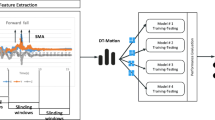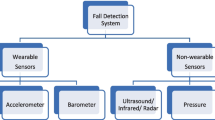Abstract
An automatic fall detection system (FDS) provides timely medical assistance to the elderly by predicting falls and non-falls, thereby preventing serious injuries and death. This article proposes an ensemble-based FDS focuses on improving the fall detection accuracy by selecting optimal classifiers with a greedy algorithm-based majority voting approach. The proposed ensemble learning is better than any of the individual models because it involves multiple machine learning models along with deep learning model, namely Support Vector Machine, K-Nearest Neighbour, Decision Tree, and Deep LSTM that are combined in majority voting fashion. The greedy algorithm-based majority voting uses three searching criteria, namely forward search, backward search, and recovery search to select the optimal classifiers. The forward search fuses the classifiers based on majority voting error (MVE) and goodness of classifiers, while the backward search removes the classifier based on the majority voting improvement selection criteria. Thus, the classifiers with the lowest MVE and processing time are fused, and the others are removed. Also, the recovery search is introduced to prevent any loss of optimal classifiers by backward search. Finally, classifiers with the best performance are combined to produce accurate fall detection. Then simulation is carried out for the individual ML model, and the proposed ensemble model. According to the evaluation outcome, the proposed ensemble-based FDS achieves high accuracy (99.98%), sensitivity (99.8%), specificity (99.9%), and precision (96.23%) than the conventional approaches. Hence, the proposed ensemble-based FDS proved to enhance fall detection accuracy.









Similar content being viewed by others
References
Ambrose, A.F., Paul, G., Hausdorff, J.M.: Risk factors for falls among older adults: a review of the literature. Maturitas 75(1), 51–61 (2013)
Xiong, X., Min, W., Zheng, W.S., Liao, P., Yang, H., Wang, S.: S3D-CNN: skeleton-based 3D consecutive-low-pooling neural network for fall detection. Appl. Intell. 50(10), 3521–3534 (2020)
Li, H., Li, C., Ding, Y.: Fall detection based on fused saliency maps. Multimed. Tools Appl. 80(2), 1883–1900 (2021)
Khraief, C., Benzarti, F., Amiri, H.: Elderly fall detection based on multi-stream deep convolutional networks. Multimed. Tools Appl. 79, 19537 (2020)
Mehta, V., Dhall, A., Pal, S., Khan, S.: Motion and region aware adversarial learning for fall detection with thermal imaging. https://arxiv.org/abs/2004.08352 (2020)
Geertsema, E.E., Visser, G.H., Viergever, M.A., Kalitzin, S.N.: Automated remote fall detection using impact features from video and audio. J. Biomech. 88, 25–32 (2019)
Falls in Older Persons: Risk Factors and Prevention. https://www.ncbi.nlm.nih.gov/books/NBK235613/.. Accessed 14 Oct 2021
Islam, M.M., Tayan, O., Islam, M.R., Islam, M.S., Nooruddin, S., Kabir, M.N., Islam, M.R.: Deep learning based systems developed for fall detection: a review. IEEE Access 8, 166117–166137 (2020)
Xu, T., Zhou, Y., Zhu, J.: New advances and challenges of fall detection systems: a survey. Appl. Sci. 8(3), 418 (2018)
Cippitelli, E., Fioranelli, F., Gambi, E., Spinsante, S.: Radar and RGB-depth sensors for fall detection: a review. IEEE Sens. J. 17(12), 3585–3604 (2017)
Mubashir, M., Shao, L., Seed, L.: A survey on fall detection: principles and approaches. Neurocomputing 100, 144–152 (2013)
Gutiérrez, J., Rodríguez, V., Martin, S.: Comprehensive review of vision-based fall detection systems. Sensors 21(3), 947 (2021)
Chandra, I., Sivakumar, N., Gokulnath, C.B., Parthasarathy, P.: IoT based fall detection and ambient assisted system for the elderly. Clust. Comput. 22(1), 2517–2525 (2019)
Hafiz, F., Shafie, A.A., Khalifa, O., Ali, M.H.: Foreground segmentation-based human detection with shadow removal. In: Proceedings of the International Conference on Computer and Communication Engineering (ICCCE'10) IEEE, pp. 1–6 (2010)
Espinosa, R., Ponce, H., Gutiérrez, S., Martínez-Villaseñor, L., Brieva, J., Moya-Albor, E.: A vision-based approach for fall detection using multiple cameras and convolutional neural networks: a case study using the UP-Fall detection dataset. Comput. Biol. Med. 115, 103520 (2019)
Bulotta, S., Mahmoud, H., Masulli, F., Palummeri, E., Rovetta, S.: Fall detection using an ensemble of learning machines. In: Neural Nets and Surroundings, pp. 81–90. Springer, Berlin, Heidelberg (2013)
Sarabia-Jácome, D., Usach, R., Palau, C.E., Esteve, M.: Highly-efficient fog-based deep learning AAL fall detection system. Internet Things 11, 100185 (2020)
Cai, X., Li, S., Liu, X., Han, G.: Vision-based fall detection with multi-task hourglass convolutional auto-encoder. IEEE Access 8, 44493–44502 (2020)
Nogas, J., Khan, S.S., Mihailidis, A.: Deepfall: non-invasive fall detection with deep spatio-temporal convolutional autoencoders. J. Healthc. Inf. Res. 4(1), 50–70 (2020)
Yacchirema, D., de Puga, J.S., Palau, C., Esteve, M.: Fall detection system for elderly people using IoT and ensemble machine learning algorithm. Pers. Ubiquit. Comput. 23(5), 801–817 (2019)
Jahanjoo, A., Naderan, M., Rashti, M.J.: Detection and multi-class classification of falling in elderly people by deep belief network algorithms. J. Ambient Intell. Hum. Comput. 11, 1–21 (2020)
Farsi, M.: Application of ensemble RNN deep neural network to the fall detection through IoT environment. Alex. Eng. J. 60(1), 199–211 (2021)
Khan, S.S., Nogas, J., Mihailidis, A.: Spatio-temporal adversarial learning for detecting unseen falls. Pattern Anal. Appl. 24(1), 381–391 (2021)
Tahir, A., Morison, G., Skelton, D.A., Gibson, R.M.: A novel functional link network stacking ensemble with fractal features for multichannel fall detection. Cogn. Comput. 12(5), 1024–1042 (2020)
Ding, J., Wang, Y.: A WiFi-based smart home fall detection system using recurrent neural network. IEEE Trans. Consum. Electron. 66(4), 308–317 (2020)
Maitre, J., Bouchard, K., Gaboury, S.: Fall detection with UWB radars and CNN-LSTM architecture. IEEE J. Biomed. Health Inform. 25(4), 1273–1283 (2020)
Divya, V., Sri, R.L.: Docker-based intelligent fall detection using edge-fog cloud infrastructure. IEEE Internet Things J. 8(10), 8133–8144 (2020)
Alamuru, S., Jain, S.: Video event detection, classification and retrieval using ensemble feature selection. Clust. Comput. 24(4), 2995–3010 (2021)
Ghosh, A., Umer, S., Khan, M.K., Rout, R.K., Dhara, B.C.: Smart sentiment analysis system for pain detection using cutting edge techniques in a smart healthcare framework. Clust. Comput. 2022, 1–7 (2022). https://doi.org/10.1007/s10586-022-03552-z
Wu, C., Shao, S., Tunc, C., Satam, P., Hariri, S.: An explainable and efficient deep learning framework for video anomaly detection. Clust. Comput. 25(4), 2715–2737 (2022)
Dou, J., Yunus, A.P., Bui, D.T., Merghadi, A., Sahana, M., Zhu, Z., Pham, B.T.: Improved landslide assessment using support vector machine with bagging, boosting, and stacking ensemble machine learning framework in a mountainous watershed, Japan. Landslides 17(3), 641–658 (2020)
Liu, C.L., Lee, C.H., Lin, P.M.: A fall detection system using k-nearest neighbor classifier. Expert Syst. Appl. 37(10), 7174–7181 (2010)
Nagabushanam, P., George, S.T., Radha, S.: EEG signal classification using LSTM and improved neural network algorithms. Soft Comput. 24, 1–23 (2019)
Tian, Y., Zhang, K., Li, J., Lin, X., Yang, B.: LSTM-based traffic flow prediction with missing data. Neurocomputing 318, 297–305 (2018)
Ulaş, A., Semerci, M., Yıldız, O.T., Alpaydın, E.: Incremental construction of classifier and discriminant ensembles. Inf. Sci. 179(9), 1298–1318 (2009)
Ruta, D., Gabrys, B.: Classifier selection for majority voting. Inf. Fusion 6(1), 63–81 (2005)
Dataset link. https://imvia.u-bourgogne.fr/en/database/fall-detection-dataset-2.html
Shrivastava, R., Pandey, M.: Real time fall detection in fog computing scenario. Clust. Comput. 23(4), 2861–2870 (2020)
Funding
There is no funding for this study.
Author information
Authors and Affiliations
Contributions
All the authors SR and JS have participated in writing the manuscript and have revised the final version. All authors read and approved the final manuscript.
Corresponding author
Ethics declarations
Conflict of Interest
Authors declares that they have no conflict of interest.
Ethical approval
This article does not contain any studies with human participants and/or animals performed by any of the authors.
Informed consent
There is no informed consent for this study.
Data availability
All authors contributed to the study conception and design. Material preparation, data collection and analysis were performed by Shikha Rastogi, Jaspreet Singh. The first draft of the manuscript was written by Shikha Rastogi and all authors commented on previous versions of the manuscript. All authors read and approved the final manuscript. Conceptualization: Shikha Rastogi; Methodology: Shikha Rastogi; Formal analysis and investigation: Shikha Rastogi, Jaspreet Singh; Writing—original draft preparation: Shikha Rastogi; Writing—review and editing: Jaspreet Singh; Supervision: Jaspreet Singh.
Additional information
Publisher's Note
Springer Nature remains neutral with regard to jurisdictional claims in published maps and institutional affiliations.
Rights and permissions
Springer Nature or its licensor (e.g. a society or other partner) holds exclusive rights to this article under a publishing agreement with the author(s) or other rightsholder(s); author self-archiving of the accepted manuscript version of this article is solely governed by the terms of such publishing agreement and applicable law.
About this article
Cite this article
Rastogi, S., Singh, J. Performance enhancement of vision based fall detection using ensemble of machine learning model. Cluster Comput 26, 4119–4132 (2023). https://doi.org/10.1007/s10586-022-03818-6
Received:
Revised:
Accepted:
Published:
Issue Date:
DOI: https://doi.org/10.1007/s10586-022-03818-6




